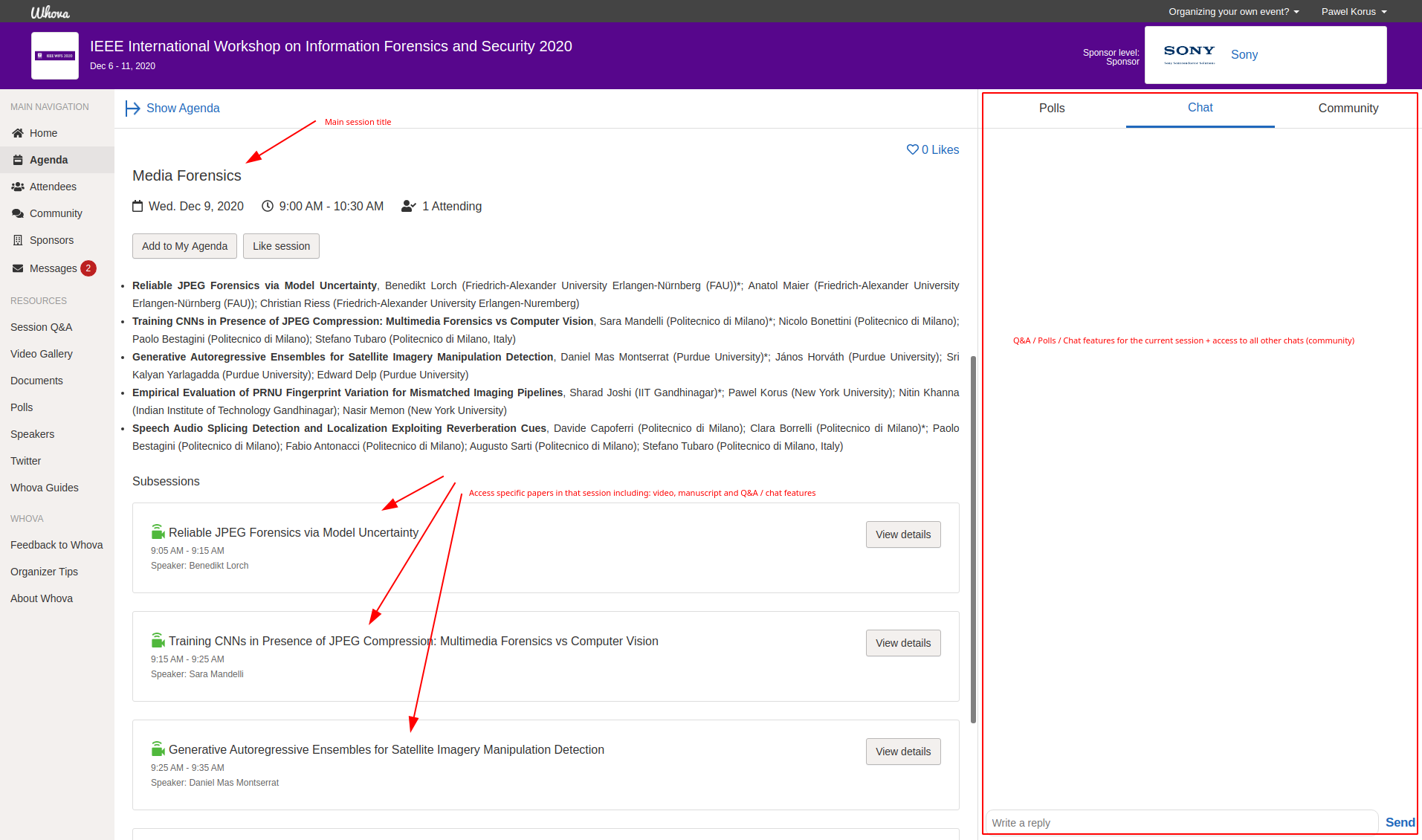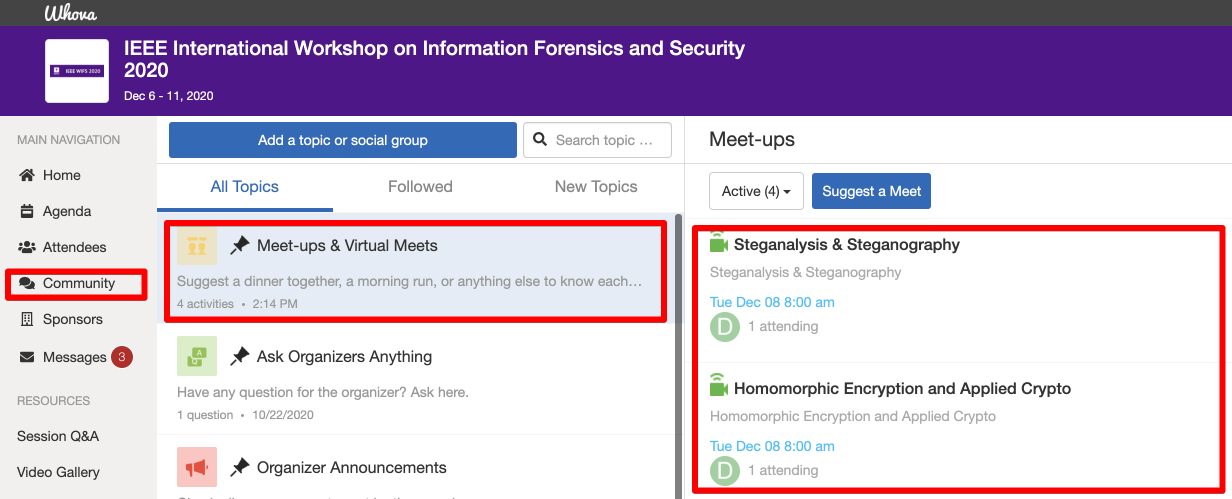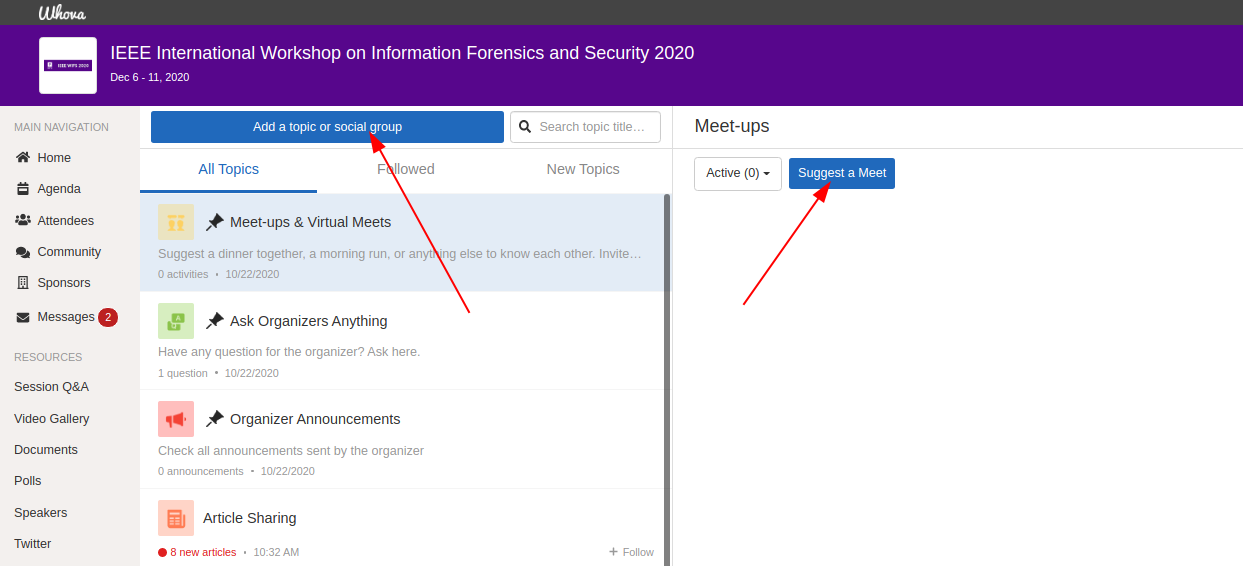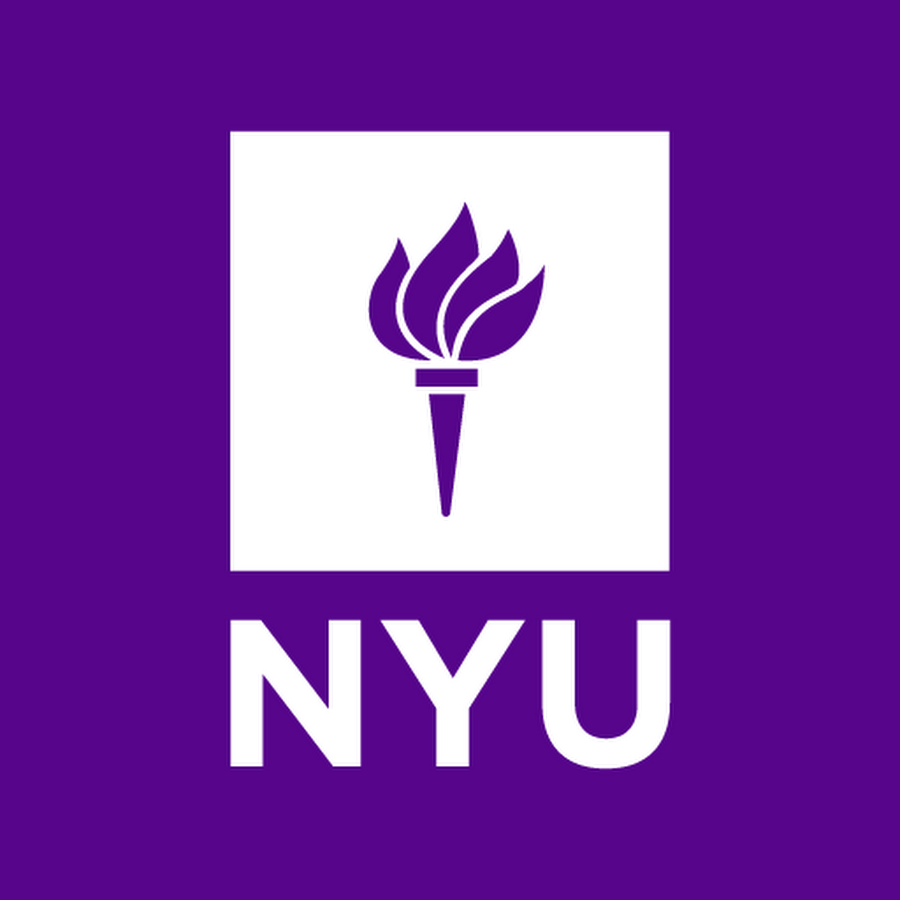Attend & Prepare
Virtual Format - Updates
Based on the feedback we received from the research community, we're making the following adjustments to the presentation format:
live technical sessions will include short live presentations instead of pre-recorded 1 min videos.
pre-recorded videos can be longer (up to 20 min),
Please see details below. The changes aim to facilitate better participation experience and take into account feedback from recent similar events.
Virtual Format - Overview
IEEE WIFS'20 will be hosted as a fully virtual event with short 3-4 hour sessions spread across 6 - 11 Dec to facilitate interaction between participants from various time zones.
Main technical papers will be presented in a hybrid format with:
a pre-recorded video (up to 20 min) that explains the paper in detail (for asynchronous watching),
live technical discussion sessions (grouped by topic): during the session, the authors will give a short presentation (~8 minutes) and answer questions from the audience,
a per-paper chat channels for offline discussions,
access to full manuscripts before the event.
In addition to the main conference track, we're planning:
invited keynotes on timely problems in the IFS space,
tutorials,
social events / thematic discussions (see details below),
an industry & applications session.
Virtual Conference Platform
We are using Whova and Zoom videoconferencing to host the event online. All features will be directly available within the conference platform and will be accessible via a Web browser and a mobile app. We give a brief overview of the conference organization below; for more information please refer to user guides:
The platform will be accessible ahead of the event and we strongly encourage you to check it out and make yourselves at home before the event. In particular, a good way to start is to setup your profile by entering basic information about you (e.g., photo, bio, interests). This will make it easier for people to find you and learn more about your work.
The platform is available at: https://whova.com/portal/webapp/iiwif1_202012/
Note that you will be asked to setup an account - please use the same email address that you used for registration.
Main Sessions
The schedule is divided into top-level sessions (with live zoom links) and individual papers are included as sub-sessions (with linked prerecorded videos and camera ready manuscripts). We recommend interested researchers to watch the videos and/or read the papers ahead of time. Live sessions will contain only very short presentations that summarize the main takeaways from the respective studies. Each (sub)session has dedicated chat / polling and Q&A functionality available on the right side of the screen (see below). This Q&A / chat sidebar is the best place to ask authors specific questions about their work.
Each technical session will be presented in the following format:
Welcome from the session chair
N short presentations from the authors,
Panel discussion with questions directed at all N papers of the session.
To ask a question, please use the "raise hand" feature of zoom and wait for the session chair to call you out. If we run out of time, you can use the per-paper chat and / or ask the author to speak in person. The virtual conference platform allows for scheduling ad hoc community meetups (see below).
We will be using the share screen feature of Zoom for the presentations, which means you can share the entire screen, a specific window, or even the screen of another device. This may be useful, for example if you're planning to scribble on your slides on an iPad. If you are a speaker, please make sure to test the device you're planning to use. Some systems (e.g., recent MacOS) may require additional permissions to record your screen. If your browser is not authorized to do this, you may run into issues. If you'd like to test screen sharing, we are planning to open the zoom rooms 20 min earlier each day (before the first session of the day).

Industry & Applications
The Industry & Applications session features a unique opportunity to directly talk to practitioners from the industry, startup community and non-governmental organizations. Each participating organization has a dedicated sub-session in the platform and a separate zoom room for video conferencing. Please use this opportunity to learn more about real-world use cases and collaboration opportunities. The information will also be summarized as extended abstracts available for download.

Networking and Community Events
To facilitate networking and meaningful discussions, we provide:
chats rooms for text-based and asynchronous communication - they can be found in the Community Board. Q&A and chats associated with specific papers are available via the sidebar for their respective sessions (see screenshot above).
two slots in the official program with breakout discussions in community meetups - unstructured discussions in virtual conference rooms.
option to create new community meetups by conference participants - these are not officially scheduled and need to be coordinated by the participants themselves
We sourced the discussion topics from the research community and from the registered participants. Then, we clustered the topics and generated time slots (grouped in A / B sessions in the program) for the most popular ones. Note that these are community discussion rooms and not structured panels. While some organizers may be attending the discussions, there will be no top-down moderation and participants are expected to self-organize.
New Chats or Meetups
You can add new chat topics and new video meetups. Both options are available via the Community section of our conference platform.
For video meetups you can supply your own video conferencing links or use the built-in feature in Whova.

Rules of Conduct - IEEE Event Conduct and Safety Policy:
IEEE believes that science, technology, and engineering are fundamental human activities, for which openness, international collaboration, and the free flow of talent and ideas are essential. Its meetings, conferences, and other events seek to enable engaging, thoughtprovoking conversations that support IEEE’s core mission of advancing technology for humanity. Accordingly, IEEE is committed to providing a safe, productive, and welcoming environment to all participants, including staff and vendors, at IEEE-related events.
IEEE has no tolerance for discrimination, harassment, or bullying in any form at IEEE-related events. All participants have the right to pursue shared interests without harassment or discrimination in an environment that supports diversity and inclusion. Participants are expected to adhere to these principles and respect the rights of others.
IEEE seeks to provide a secure environment at its events. Participants should report any behavior inconsistent with the principles outlined here, to on site staff, security or venue personnel, or to eventconduct@ieee.org.
Registration
Per IEEE policy for virtual events, registration is free for all non-author participants. At least one author of each accepted papers must register for a fee according to their IEEE membership level. A detailed breakdown is shown below. Please note that each paper must have 1 fully paid registration and each registration can cover up to 4 papers (co-)authored by the registrant. All other authors can register for free at the non-author rate.
Please note that there are no early-bird / late registrations. At least one author for each accepted paper must register before (Friday) Nov 20 (Friday) Nov 6 23:59 Anywhere on Earth. For all other participants, registration will remain open until the event.
Registration includes full access to the virtual conference and all sessions, the conference app, as well as any live and asynchronous discussion forums, and an electronic download of the conference proceedings.
Presentation Format
Main technical papers will be presented in a hybrid format with:
a pre-recorded video (up to 20 min) that explains the paper in detail (for asynchronous watching),
a pre-recorded 1 min recap video (will be played as a reminder at the beginning of live technical Q&A sessions),live technical discussion sessions (grouped by topic): during the session, the authors will give a short presentation (~8 minutes) and answer questions from the audience,
a per-paper chat channels for asynchronous discussions,
access to full manuscripts before the event.
Video Submission
We will be collecting video presentations until (Tuesday) Nov 24 23:59 Anywhere on Earth. Videos that are not received by the deadline will be considered no-shows. We thank you for your cooperation in this endeavor. Detailed submission instructions will be available soon.
Please follow the following video preparation guidelines:
Videos should be prepared offline and should be uploaded to the system,
Main papers presentations: max duration 20 minutes, limited to 100MB file size
Recap video (for Q&A session):max duration 1 minute, limited to 10 MB file sizeVideo file format: mp4 with H.264 video encoding and MP3 or AC3 audio encoding
Dimensions: Minimum height 720 pixels, aspect ratio: 16:9
In the main video, your first slide should be an introduction slide that has your paper title, the presenter’s name , and the authors’ names & affiliations. Showing a speaker view is recommended but not compulsory. If you choose to do so, please make sure the speaker window is not covering slides.
Tips for recording:
Use as quiet an area as possible and avoid environments with echo.
We recommend using a good headset with microphone close to mouth, but away from direct line of mouth to reduce “pops”.
The presentations should be a concise summary of the work and include: motivation, contributions, overview of the experimental setup, key results and conclusions. Please redirect viewers to the manuscript for details.
The recap video is meant as a quick refresher for viewers before the Q&A session. The videos will be played back at the beginning of the session. We recommend using a single slide with paper title, problem statement and key results / conclusions.
Please review the entire recording to make sure the presentation is visible and the speech audible. It's best to avoid / remove long silence segments. Feel free to use video editing tools.
Some recommended tools include (list not exhaustive):
Recording: monosnap / OBS studio
Technical Sessions
To enable live discussions with authors, WIFS 2020 will feature live technical sessions (grouped by topic) where delegates first give a short overview of their work (~8 minutes). After all papers have been presented, participants can ask questions related to any of the papers in the session. At least one author must participate in their corresponding session. Lack of participation will be considered as no-show and may result in removal of your papers from the final proceedings in IEEE Xplore.
Chat and Offline Discussions
Each paper will have a dedicated chat available within the conference system and meant for offline discussions. Per IEEE policy, authors are expected to respond to posted questions within 72 hours. Failure to respond to questions will be considered as no-show and may result in removal of your papers from the final proceedings in IEEE Xplore.
Video Upload Instructions
We are collecting prerecorded videos directly in the virtual conference platform. Primary contact authors for each paper will receive a personalized link to the video submission form. We will be sending out the emails on Friday 20 Nov 2020. Please monitor your inbox!
